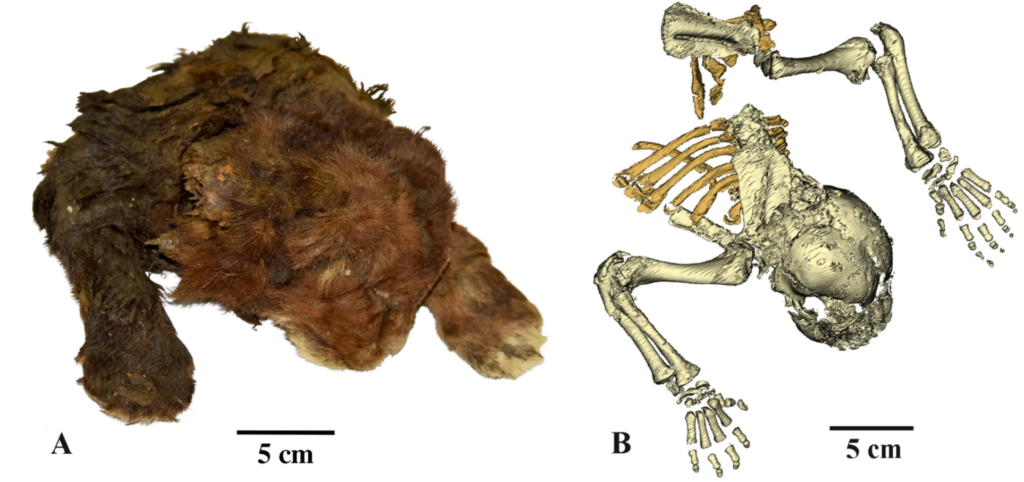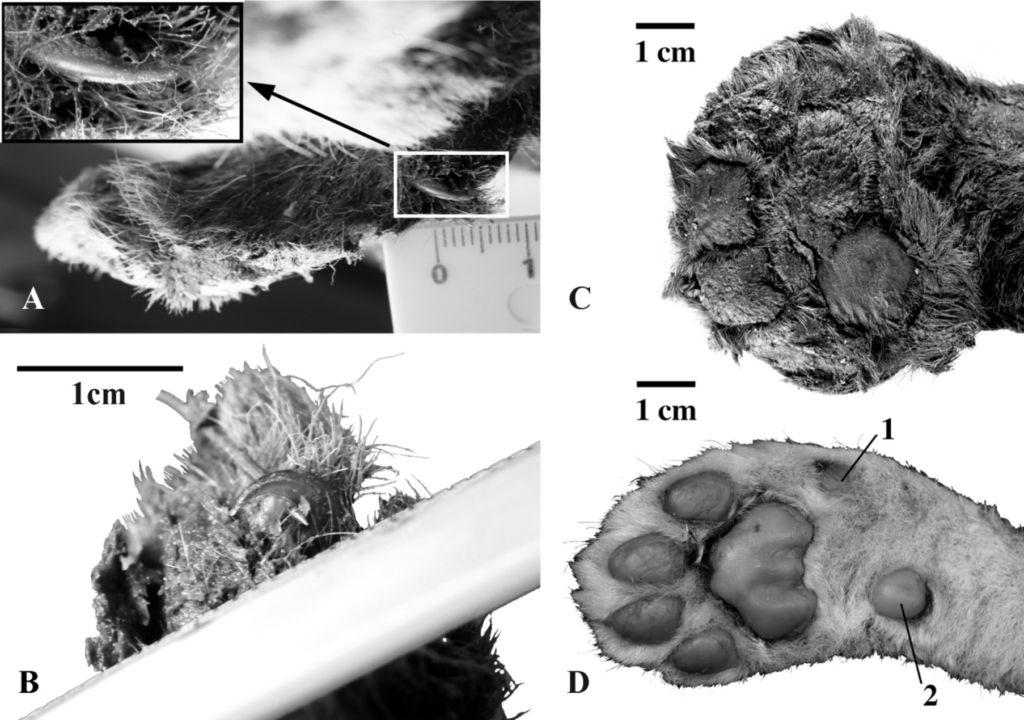In the permafrost of Siberia, a remarkable discovery has been made—a mummified juvenile sabretooth cat, Homotherium latidens, frozen in time for over 35,000 years. This discovery, made along the Badyarikha River in the Indigirka River Basin of Yakutia, Russia, offers an exciting glimpse into a species that has no modern analog (a living equivalent of something extinct) (1). For paleontologists and evolutionary biologists, it provides an unprecedented look at an ancient predator that roamed the Earth during the Ice Age. So, how is this cub mummy truly fascinating scientists?
A Rare Find

The permafrost of Siberia is a treasure trove of Ice Age fossils, but the discovery of a mummified Homotherium cub stands out for its rarity and significance. While bones can tell us a lot about the history of an extinct species, mummies—where the animal’s soft tissues, such as fur, skin and sometimes internal organs, are preserved—offer far more detailed information. ‘Mummies’ refer to animals (or humans) that have been preserved with their soft tissues intact, often through natural or intentional processes like drying or embalming. This preservation allows scientists to gain insights into the organism’s diet, health, development and adaptations—details that bones alone can’t reveal!
This specimen retains soft tissues, fur and even muscle structure – allowing scientists to study its anatomy in extraordinary detail. Radiocarbon dating, done through analyzing the fur, determined the mummy was approximately 35,000 years old, aligning with the Upper Pleistocene epoch—a time when Homotherium roamed alongside mammoths and other Ice Age giants (1). So, the cub’s preserved state offers insights into not only its species but also the harsh environment it inhabited.
What Makes the Hometherium Unique?
Homotherium latidens, also known as the scimitar-toothed cat, was a member of the Machairodontinae subfamily, a group broadly referred to as sabretooth cats. These extinct felines are characterized by their elongated canines, which vary in shape and function across species. While Smilodon—the “sabre-toothed tiger” made famous by Diego in the Ice Age films—had long, curved canines built for ambush hunting, Homotherium had shorter, serrated canines optimized for endurance hunting over open terrain (1).
Its adaptations included elongated forelimbs for pursuit while hunting, a robust neck for subduing prey and specialized teeth for slicing flesh efficiently. This mummy confirms that Homotherium was well-suited to the cold climates of Siberia, with thick, dark fur and small ears adapted for frigid temperatures, much like modern Arctic animals today (1).
Science of Preservation:
Since the mummy was found with the head and upper body largely intact, scientists could conduct CT scans and 3D modeling to analyze the anatomy of the specimen without damage. Findings included:
- Distinctive skull features, such as elongated facial bones, large cone-shaped incisors and a deep jaw flange, highlighting Homotherium’s specialized adaptations (1).
- The neck and forelimbs were more developed than modern lion cubs of similar age, underscoring the unique Homotherium physiology (1).
- The presence of soft tissue and fur allowed for the study of muscle mass and body covering, providing a clue into how these Homotherium survived the icy habitat (1).
Comparing Past to Present
Without a modern analog, big cats like lions and tigers provide the closest reference for scientists to interpret the anatomy and behavior of the Homotherium. For example:
- The mummy cubs’ neck was more than twice as thick as that of a lion cub, reflecting powerful muscles adapted for subduing prey (1).
- Its paw structure featured subsquare pads and lacked a carpal pad, suggesting snow-walking adaptations similar to modern lynxes (1).

- Its thick, dark fur and small ears were clear adaptations for colder climates, highlighting its ability to thrive in Ice Age environments (1).
By continuing to examine the differences between these extinct species and modern animals, scientists can better understand how these animals carved out ecological niches and survived in the ancient world.
Why Does This Study Matter?
The Homotherium cub mummy is more than just a paleontological marvel—it’s a key to unlocking broader questions about evolution, extinction and adaptation. Here’s why it’s so significant:
- Understanding Evolutionary Links: By exploring the evolutionary history of big cats, like the Homotherium and how they diverged from the Machairodontinae lineage, we might get an idea into how biodiversity can shift over time.
- Understanding Ice Age Ecosystems: Studying the Homotherium can help researchers reconstruct predator-prey dynamics and environmental conditions during the Pleistocene, including maybe how the ecosystem adapted during climate shifts.
- Revealing Juvenile Development: Most importantly, most studies of extinct species focus on adult specimens, as juveniles are rarely preserved. This juvenile mummy provides a rare glimpse into the early stages of life for a Homotherium, offering clues about things like growth, survival strategies, ontogenetic insights and more.
A Frozen Legacy: Homotherium
The juvenile Homotherium latidens mummy is more than just a scientific marvel—it’s a story frozen in time. It serves as a powerful reminder of the extraordinary diversity of life that once roamed Earth and the interconnectedness of all living things, whether plant, predator or prey. This discovery not only deepens our understanding of the past but also paves the way for future research that could reshape our knowledge of Earth’s history and biodiversity. With today’s advanced tools and technology, unlocking the secrets of the Ice Age and beyond feels more achievable than ever.
Citation
- Lopatin, A. V., Sotnikova, M. V., Klimovsky, A. I., Lavrov, A. V., Protopopov, A. V., Gimranov, D. O., & Parkhomchuk, E. V. (2024). Mummy of a juvenile sabre-toothed cat Homotherium latidens from the Upper Pleistocene of Siberia. Scientific Reports, 14(1). https://doi.org/10.1038/s41598-024-79546-1
Latest posts by Shannon Sindermann (see all)
- Can Fungi Help Clean Up Environmental Contaminants? - March 20, 2025
- Reprogramming T Cells with DCA: A Metabolic Breakthrough - February 7, 2025
- Do Zebrafish Hold the Key to Heart Regeneration? - January 14, 2025
